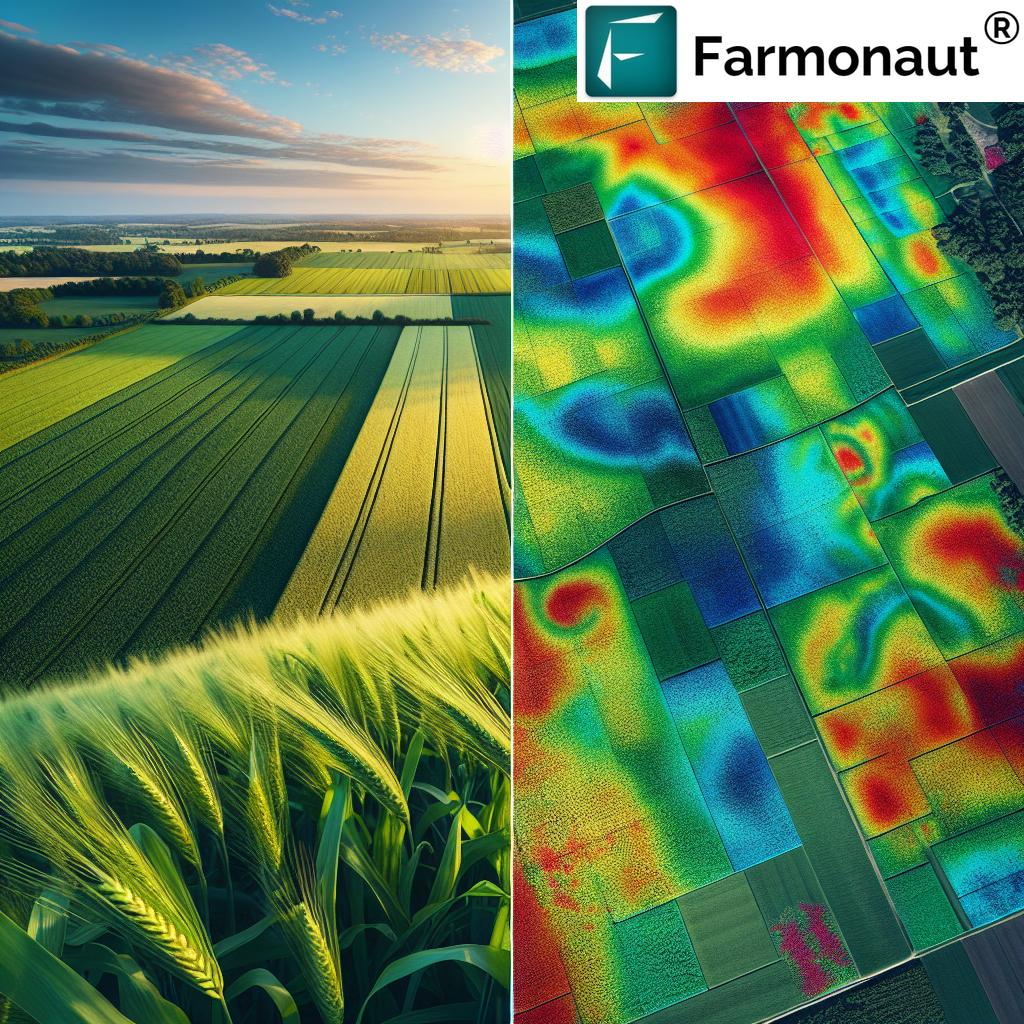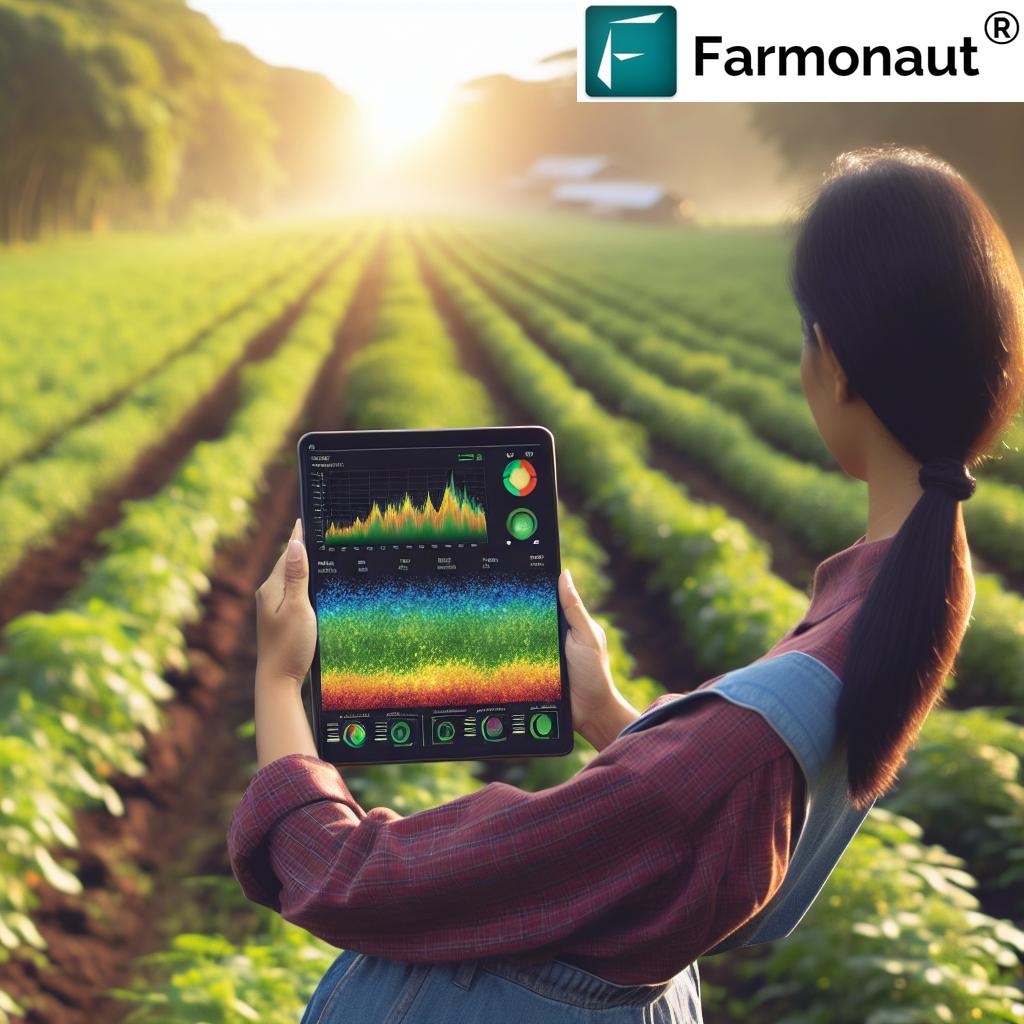Revolutionizing Precision Agriculture: How Satellite NDVI Monitoring Enhances Crop Health and Harvest Yields

In the ever-evolving landscape of modern agriculture, we at Farmonaut are at the forefront of a technological revolution that is transforming the way farmers approach crop management and harvest optimization. Our innovative use of satellite-based Normalized Difference Vegetation Index (NDVI) monitoring is changing the game for precision agriculture, offering unprecedented insights into crop health and field conditions. This blog post delves deep into how our cutting-edge technology is enhancing agricultural practices, improving crop yields, and paving the way for a more sustainable future in farming.
Understanding NDVI and Its Role in Precision Agriculture
NDVI, or Normalized Difference Vegetation Index, is a crucial tool in our arsenal for precision agriculture. This remote sensing technique allows us to assess the health and vigor of vegetation across vast areas with remarkable accuracy. By measuring the difference between near-infrared light (which healthy vegetation strongly reflects) and red light (which vegetation absorbs), NDVI provides a numerical value that indicates the density and health of green vegetation in a given area.
Here’s why NDVI is so valuable for farmers and agricultural professionals:
- Accurate Crop Health Assessment: NDVI values correlate strongly with plant health, allowing for early detection of stress factors such as disease, pest infestation, or nutrient deficiencies.
- Large-Scale Monitoring: Satellite-based NDVI can cover extensive areas quickly, making it ideal for monitoring large fields or multiple farms simultaneously.
- Temporal Analysis: Regular NDVI measurements enable the tracking of crop development over time, providing insights into growth patterns and potential yield.
- Resource Optimization: By identifying areas of stress or low productivity, farmers can target their resources more effectively, reducing waste and improving overall efficiency.
The Power of Satellite Technology in Agriculture
At Farmonaut, we harness the power of satellite technology to bring NDVI monitoring to farmers across the globe. Our advanced satellite imagery provides a bird’s-eye view of agricultural lands, offering unparalleled insights into crop conditions. Here’s how satellite technology is revolutionizing agriculture:
- Wide Coverage: Satellites can capture images of vast areas in a single pass, allowing for comprehensive monitoring of large agricultural regions.
- Frequent Updates: Regular satellite passes provide up-to-date information, enabling farmers to track changes in their fields over time.
- Non-Invasive Monitoring: Unlike ground-based methods, satellite monitoring doesn’t require physical access to the fields, reducing disturbance to crops and soil.
- Cost-Effective: Satellite monitoring eliminates the need for expensive on-ground sensors or frequent manual inspections, making precision agriculture more accessible to farmers of all scales.
How Farmonaut’s NDVI Monitoring Enhances Crop Health
Our satellite-based NDVI monitoring system is designed to provide farmers with actionable insights that directly impact crop health and productivity. Here’s how we’re making a difference:
- Early Detection of Crop Stress: By analyzing NDVI data, we can identify areas of crop stress before they become visible to the naked eye. This early warning system allows farmers to intervene quickly, potentially saving entire harvests.
- Precision Irrigation Management: NDVI data helps in assessing soil moisture levels, enabling farmers to optimize their irrigation schedules and reduce water waste.
- Targeted Fertilizer Application: By identifying areas of low vegetation health, farmers can apply fertilizers more precisely, reducing costs and minimizing environmental impact.
- Pest and Disease Management: Changes in NDVI values can indicate the presence of pests or diseases, allowing for targeted treatment and reducing the need for broad-spectrum pesticides.
- Yield Prediction: Historical NDVI data, combined with other factors, can help in predicting crop yields, enabling better harvest planning and market strategies.

The Impact on Harvest Yields
The ultimate goal of precision agriculture is to improve harvest yields while optimizing resource use. Our satellite NDVI monitoring technology has shown significant impacts on harvest outcomes:
- Increased Crop Productivity: By enabling timely interventions and optimized resource allocation, farmers using our technology have reported yield increases of up to 20% in various crops.
- Improved Crop Quality: Better management of crop health throughout the growing season leads to higher quality produce at harvest time.
- Reduced Crop Losses: Early detection of issues allows farmers to mitigate potential losses, significantly improving overall harvest yields.
- Optimized Harvest Timing: NDVI data helps determine the optimal time for harvest, ensuring crops are collected at peak maturity.
Farmonaut’s Technology in Action: A Comparison
To illustrate the advantages of our satellite NDVI monitoring system, let’s compare traditional farming methods with Farmonaut’s approach:
| Aspect | Traditional Farming Methods | Farmonaut Satellite NDVI Monitoring |
|---|---|---|
| Crop Health Assessment | Visual inspection, limited to visible symptoms | Comprehensive, data-driven analysis detecting issues before visible symptoms appear |
| Field Monitoring Frequency | Irregular, dependent on manual scouting | Regular, automated monitoring with frequent satellite passes |
| Early Issue Detection | Limited to visible problems, often detected late | Early detection of stress, diseases, and pests through NDVI analysis |
| Precision in Decision Making | Based on experience and general observations | Data-driven decisions supported by precise NDVI measurements |
| Cost-Effectiveness | High labor costs for manual field inspections | Reduced labor costs, more efficient resource allocation |
Implementing Satellite NDVI Monitoring in Your Agricultural Practice
Adopting our satellite NDVI monitoring technology is straightforward and can be integrated into existing farming practices with ease. Here’s how you can get started:
- Sign Up for Farmonaut: Visit our website at https://farmonaut.com/app_redirect to create an account and select a plan that suits your needs.
- Define Your Fields: Use our user-friendly interface to outline your fields on a map. This helps us target our satellite monitoring to your specific areas of interest.
- Access NDVI Data: Once set up, you’ll start receiving regular NDVI updates for your fields. These can be accessed through our web platform or mobile app.
- Interpret the Data: Our system provides easy-to-understand visualizations of NDVI data, along with actionable insights and recommendations.
- Implement Precision Agriculture Practices: Use the insights gained from NDVI monitoring to make informed decisions about irrigation, fertilization, and pest management.
For those interested in integrating our technology into their own systems, we offer API access. Developers can find more information at https://sat.farmonaut.com/api and https://farmonaut.com/farmonaut-satellite-weather-api-developer-docs/.
The Future of Precision Agriculture with Farmonaut
As we continue to innovate and refine our technology, the future of precision agriculture looks brighter than ever. Here are some exciting developments on the horizon:
- AI-Powered Predictions: We’re working on advanced AI algorithms that will provide even more accurate yield predictions and pest outbreak forecasts.
- Integration with IoT Devices: Future updates will allow seamless integration with on-ground IoT sensors, providing a comprehensive view of field conditions.
- Climate Change Adaptation: Our technology will play a crucial role in helping farmers adapt to changing climate patterns, ensuring food security in the face of environmental challenges.
- Biodiversity Monitoring: Expanding beyond crop health, we’re exploring ways to use satellite data to monitor and protect biodiversity in agricultural landscapes.
Conclusion: Embracing the Future of Farming
The integration of satellite NDVI monitoring into precision agriculture represents a significant leap forward in our ability to manage crops efficiently and sustainably. At Farmonaut, we’re proud to be at the forefront of this revolution, providing farmers with the tools they need to optimize their harvests, reduce resource waste, and adapt to the challenges of modern agriculture.
By embracing this technology, farmers can not only improve their yields and profitability but also contribute to more sustainable agricultural practices that benefit the entire planet. As we move forward, the combination of satellite technology, data analytics, and on-ground expertise will continue to shape the future of farming, ensuring food security for generations to come.
Ready to revolutionize your farming practices? Visit https://farmonaut.com/app_redirect to get started with Farmonaut’s satellite NDVI monitoring technology today. For mobile users, our app is available on both Google Play and the App Store.
FAQs
Q: What is NDVI, and how does it help in agriculture?
A: NDVI (Normalized Difference Vegetation Index) is a remote sensing technique that measures the health and density of vegetation. In agriculture, it helps assess crop health, detect stress, and optimize resource management, leading to improved yields and more sustainable farming practices.
Q: How often are satellite images updated in Farmonaut’s system?
A: The frequency of satellite image updates depends on the specific plan you choose. Generally, we provide updates every 3-5 days, ensuring you have timely information about your fields.
Q: Can Farmonaut’s technology be used for all types of crops?
A: Yes, our satellite NDVI monitoring can be used for a wide variety of crops, including grains, fruits, vegetables, and even in orchards. The technology is adaptable to different vegetation types and growing conditions.
Q: How accurate is satellite-based NDVI monitoring compared to ground-based methods?
A: Satellite-based NDVI monitoring has proven to be highly accurate, often detecting issues before they’re visible to the naked eye. While ground-based methods can provide more detailed data for small areas, satellite monitoring offers unparalleled coverage and consistency for large-scale agriculture.
Q: Is Farmonaut’s technology suitable for small-scale farmers?
A: Absolutely! We’ve designed our platform to be accessible and beneficial for farmers of all scales. Our flexible pricing and easy-to-use interface make precision agriculture technology available to small-scale farmers, helping them compete in the modern agricultural landscape.
Q: How does Farmonaut’s technology contribute to sustainable agriculture?
A: By optimizing resource use (water, fertilizers, pesticides) and improving crop health management, our technology helps reduce waste and environmental impact. This leads to more sustainable farming practices and helps in the conservation of natural resources.
Subscribe to Farmonaut
Ready to transform your agricultural practices with cutting-edge satellite NDVI monitoring? Subscribe to Farmonaut today and start optimizing your crop health and harvest yields!